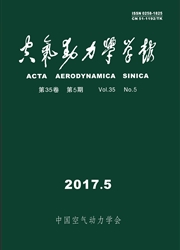

 中文摘要:
中文摘要:
采用气动力/气动热/热结构相耦合的方法对高超飞行器机翼结构静态热气动弹性问题进行了研究。为保证耦合计算效率,达到快速预测热气动弹性特性的能力,气动力/气动热计算采用工程方法,热响应和热应力/热变形计算采用有限元方法。以典型高超声速飞行器机翼模型为研究对象,对其热气动弹性特性进行了计算与分析。计算结果表明,气动加热造成的结构温升不仅对材料热物性参数产生影响,对机翼模型的气动弹性特性也影响显著。准确预测飞行器热气动弹性特性对飞行器结构设计十分必要。
 英文摘要:
英文摘要:
Aerothermoelasticity characteristic of new generation hypersonic vehicle becomes more and more important, especially for those vehicles with long flight duration, medium heat flux, non-ablation material and structure, relative complex configuration with thin wing and/or flaps. Heat environment and temperature responsibility of vehicle structure affect vehicle structural aeroelasticity obviously and cannot af- ford to be ignored. Static aerothermoelasticity for the wing of a hypersonic vehicle is studied using a multi- field coupling method including aerodynamics, thermodynamics and heat structure response analysis. Valida- ted engineering methods are adopted to predict aerodynamic and thermodynamics characteristics to ensure the computational efficiency, while finite element method are used to solve heat response and heat stress/de- formation behavior. The simulation results for the wing of a typical hypersonic cruise vehicle show that structural temperature increase due to aerodynamic heating affect not only the thermophysics parameters, but also the aeroelastic characteristic significantly. The deformation and the corresponding vibration frequen- cy may affect further the aerodynamics characteristics, the flight stability and the control efficiency of the vehicle. Accurate prediction of the aerothermoelastic characteristics is essential for the design of hypersonic vehicle structure.
 同期刊论文项目
同期刊论文项目
 同项目期刊论文
同项目期刊论文
 期刊信息
期刊信息
